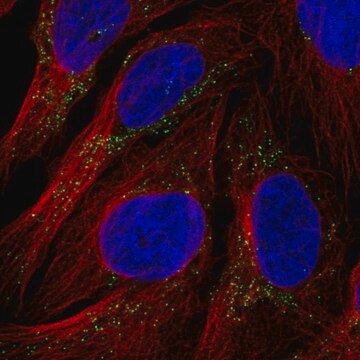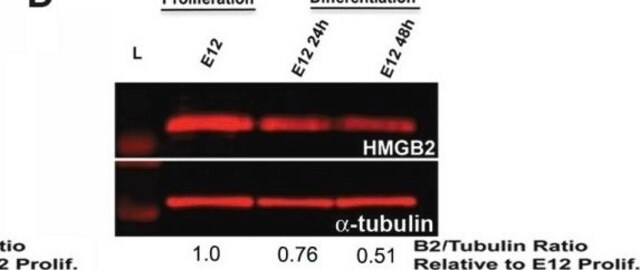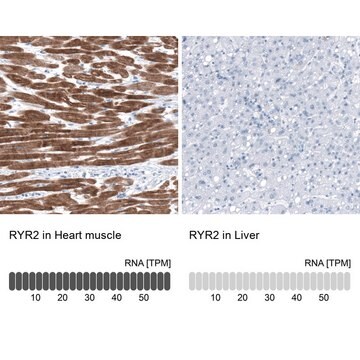AB9082
Anti-Ryanodine Receptor 3 Antibody
serum, Chemicon®
About This Item
Prodotti consigliati
Origine biologica
rabbit
Livello qualitativo
Forma dell’anticorpo
serum
Tipo di anticorpo
primary antibodies
Clone
polyclonal
Reattività contro le specie
rat, mouse, human
Produttore/marchio commerciale
Chemicon®
tecniche
immunocytochemistry: suitable
immunohistochemistry: suitable
western blot: suitable
N° accesso NCBI
N° accesso UniProt
Condizioni di spedizione
dry ice
modifica post-traduzionali bersaglio
unmodified
Informazioni sul gene
human ... RYR3(6263)
Specificità
Immunogeno
Applicazioni
Neuroscience
Ion Channels & Transporters
Signaling Neuroscience
Immunocytochemistry: 1:1,000
Immunohistochemistry: 1:1,000 overnight at 2-8°C using a fluorescently labeled secondary antibody. Suggested fixative is 4% paraformaldehyde in 0.1M PBS (one hour). Suggested permeablization method is 0.05% Triton X-100 in dilution buffer. Suggested blocking buffer is 10% normal goat serum (or same host as your secondary antibody) and 1% BSA in 0.1M PBS. Suggested dilution buffer is 1% normal goat serum (or same host as your secondary antibody) and 1% BSA in 0.1M PBS.Optimal working dilutions must be determined by the end user.
Stato fisico
Stoccaggio e stabilità
Risultati analitici
Western blot = adult mouse brain (adult mouse skeletal muscle will be negative).
IHC = adult mouse cerebellum Purkinje cells (adult mouse cerebellum granular cells will be negative).
Note legali
Esclusione di responsabilità
Non trovi il prodotto giusto?
Prova il nostro Motore di ricerca dei prodotti.
Codice della classe di stoccaggio
10 - Combustible liquids
Classe di pericolosità dell'acqua (WGK)
WGK 1
Punto d’infiammabilità (°F)
Not applicable
Punto d’infiammabilità (°C)
Not applicable
Certificati d'analisi (COA)
Cerca il Certificati d'analisi (COA) digitando il numero di lotto/batch corrispondente. I numeri di lotto o di batch sono stampati sull'etichetta dei prodotti dopo la parola ‘Lotto’ o ‘Batch’.
Possiedi già questo prodotto?
I documenti relativi ai prodotti acquistati recentemente sono disponibili nell’Archivio dei documenti.
Il team dei nostri ricercatori vanta grande esperienza in tutte le aree della ricerca quali Life Science, scienza dei materiali, sintesi chimica, cromatografia, discipline analitiche, ecc..
Contatta l'Assistenza Tecnica.







